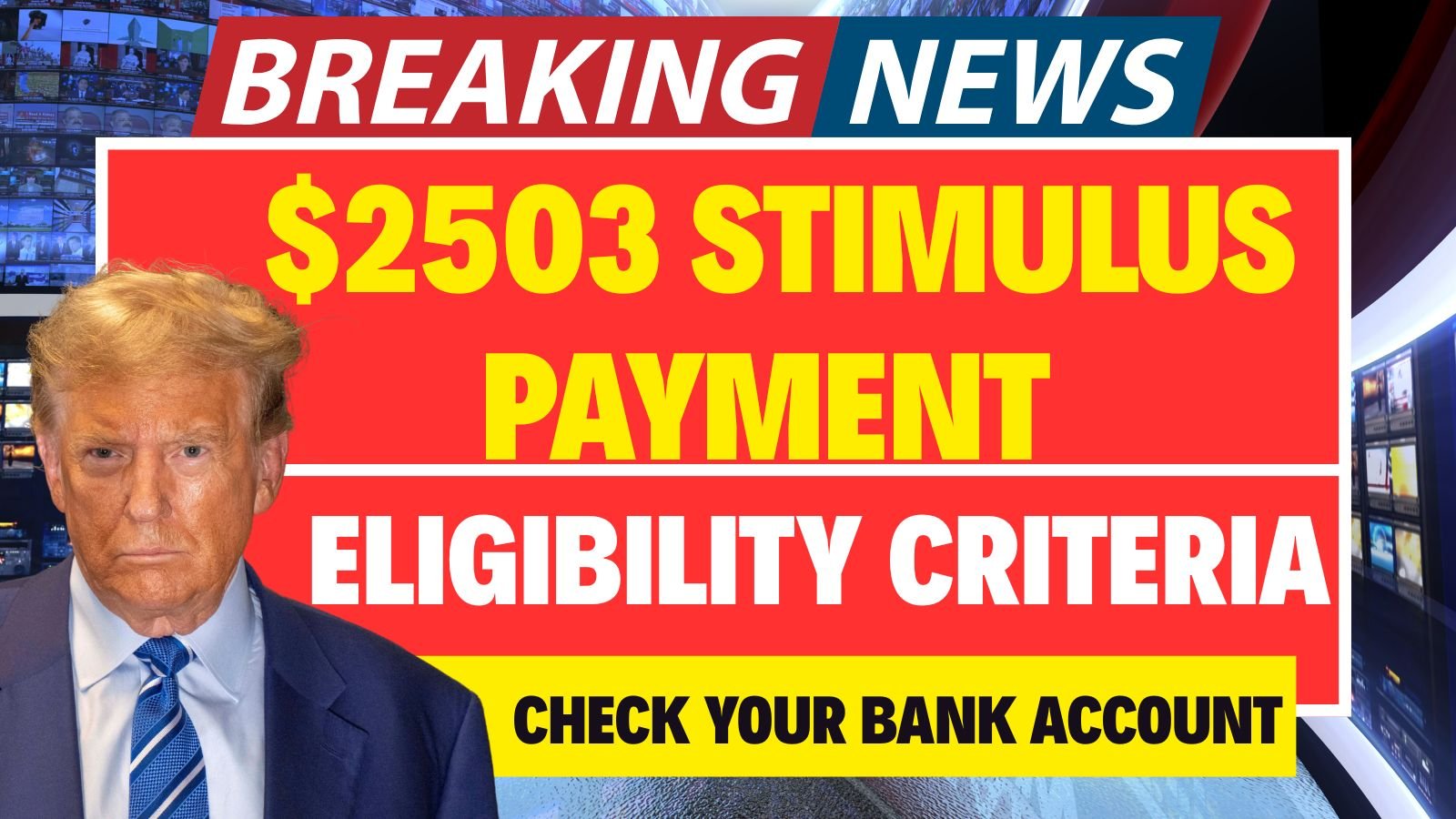As we move deeper into July 2025, growing discussions have emerged surrounding the so-called $2,503 Stimulus Payment. With inflation impacting groceries, housing, and everyday bills, families across the country are hoping for financial relief. But as hopeful as this news may seem, it’s important to examine the facts. Is there really a federal $2,503 stimulus check on the way? Where is this figure coming from? Who is eligible to receive it—and how?
Let’s unpack the real story behind the $2,503 Stimulus Payment and help you understand whether you might benefit from it.
What Is the $2,503 Stimulus Payment ?
Contrary to popular belief circulating on social media platforms, the $2,503 Stimulus Payment is not an officially announced federal relief check. There has been no formal communication from the Internal Revenue Service (IRS) or the U.S. Department of the Treasury confirming a payment of this exact amount. However, some Americans may still receive a payment around this figure from state-level programs, local government assistance, or tax-related refunds.
The confusion largely stems from a mix of online speculation and real stories of people receiving checks close to that number through varied sources. Some may qualify for a refund, credit, or relief check that coincidentally totals approximately $2,503. Others might add up different forms of state and federal aid to reach that amount.
Regardless, it’s crucial to rely on verified government sources—such as the IRS or your state’s department of revenue—to confirm whether you qualify for any such payment.
Eligibility Criteria for the $2,503 Stimulus Payment
Although there is no federal $2,503 Stimulus Payment being issued to every citizen, certain individuals may qualify for a relief amount near or equal to that figure. These payments could come through one or a combination of:
- State Relief Programs
- Federal Tax Refunds
- Recovery Rebate Credits
- Child Tax Credit Refunds
- Housing, Utility, or Energy Relief Initiatives
Here’s a breakdown of the eligibility conditions that might qualify someone for a payment near $2,503:
1. State-Based Rebates or Support
Several states have independently issued rebate checks to residents based on income thresholds, filing status, or pandemic-related losses. In some cases, these rebates have approached or matched the $2,503 mark—particularly for families with dependents.
2. Missed Federal Stimulus Payments
If you didn’t receive one of the earlier federal stimulus checks in 2020 or 2021, you might still be eligible to claim it through the Recovery Rebate Credit. The refund amount, in combination with other tax credits, could total as much as $2,503 depending on your situation.
3. Child Tax Credit Refunds
Parents or guardians who meet income eligibility may qualify for significant refunds from the Child Tax Credit program. Depending on the number of children, a refund can easily add up to or exceed the $2,503 Stimulus Payment benchmark.
4. Housing and Utility Relief
Programs offering rent assistance, energy rebates, or emergency shelter funding may provide one-time payments or benefits that approach this figure—particularly in high-cost-of-living areas.
Why the $2,503 Stimulus Payment Matters
For struggling families, receiving a payment of $2,503 can be more than just a financial lifeline—it can offer peace of mind, stability, and breathing room. Here’s how such a payment could make an impact:
- Covers Essential Living Costs: Rent, utility bills, groceries, child care, and transportation costs are rising. A $2,503 Stimulus Payment can cover several weeks’ worth of basic living expenses.
- Debt Reduction: For individuals dealing with credit card debt or unpaid loans, this payment offers a chance to bring accounts current and avoid late fees or damage to credit scores.
- Emergency Preparedness: Even if not urgently needed, setting aside a portion of the $2,503 Stimulus Payment can help create a financial buffer for unforeseen situations like medical expenses or job loss.
The key takeaway is that even though the amount isn’t universally distributed, it still holds critical value for those who are eligible.
Common Sources of the $2,503 Stimulus Payment
If you’re wondering how someone might actually receive a payment close to $2,503, here are the most common sources of such funds:
| Program Name | Type of Support | Average Amount | Eligible Recipients |
|---|---|---|---|
| State Rebate Programs | One-time relief payment | $500–$2,500 | Low- to middle-income taxpayers |
| Recovery Rebate Credit | Federal tax refund | Up to $3,000 | People who missed earlier stimulus payments |
| Child Tax Credit Refund | Refundable tax credit | Varies per child | Parents or guardians with dependent children |
| Energy or Rent Assistance | Emergency support payment | $300–$2,503 | Low-income families and renters |
Each of these programs has its own application process, documentation requirements, and timelines. Stay informed by checking your local government’s or IRS’s official portals.
Smart Ways to Use the $2,503 Stimulus Payment
If you do receive a $2,503 Stimulus Payment, how you use it can influence your financial well-being. Here’s a checklist to ensure you’re maximizing its value:
- Update Banking Details
Double-check your direct deposit information to avoid delays in payment. - Plan Your Expenses
Prioritize critical needs—housing, food, healthcare—before spending on wants or luxuries. - Avoid Scams
Be cautious of emails, texts, or calls promising instant payment of $2,503. Scammers often exploit trending topics. Stick to government websites for information. - Create an Emergency Fund
Even saving $500–$1,000 from the $2,503 Stimulus Payment can set you up for greater resilience against future hardships. - Pay Down High-Interest Debt
If you’re carrying credit card balances, using part of the payment to reduce what you owe can save money in the long run.
Latest Updates on the $2,503 Stimulus Payment
As of now, no nationwide federal $2,503 Stimulus Payment has been confirmed. However, several states are finalizing budget proposals that include direct payments or tax credits. Others are still distributing delayed refunds or credits for the past tax year.
Tax professionals suggest keeping an eye on:
- Your IRS account for credits or backdated refunds
- State tax websites for special relief initiatives
- Updates to the Child Tax Credit or Earned Income Tax Credit (EITC) provisions
Some individuals may also see IRS notices regarding amended returns, which could result in unexpected refunds close to $2,503.
Frequently Asked Questions
Who is eligible for the $2,503 Stimulus Payment?
There is no single eligibility rule. Some may qualify based on income, family size, or missed prior payments. Others may receive similar payments through state programs or tax credits.
How should I spend the $2,503 Stimulus Payment?
The best approach is to first address essentials like rent, groceries, and utilities. Any remaining funds can go toward savings or debt reduction.
Is the $2,503 Stimulus Payment taxable?
It depends on the source. Some tax refunds or credits are not taxable, while other payments may be reportable income. Consult a certified tax professional to understand your specific situation.
When will I receive the $2,503 Stimulus Payment?
If you qualify, payment timelines depend on the issuing agency. Tax-related refunds often take a few weeks, while state programs may take longer to process.
Final Thoughts
The idea of a $2,503 Stimulus Payment has gained a lot of attention—and for good reason. In a time when every dollar counts, even the possibility of such support offers hope. While there isn’t a blanket federal payment of this exact amount, there are multiple ways some Americans may receive similar relief.
Stay informed, protect yourself from scams, and use any funds received wisely. Whether you qualify through a rebate, refund, or credit, this one-time payment could provide the boost you need to regain financial footing.
Some Important Link
| Download News APP | Click Here |
| WhatsApp Group | Click Here |
| Home Page | Click Here |
















